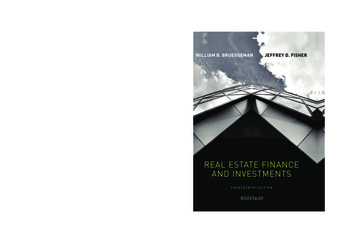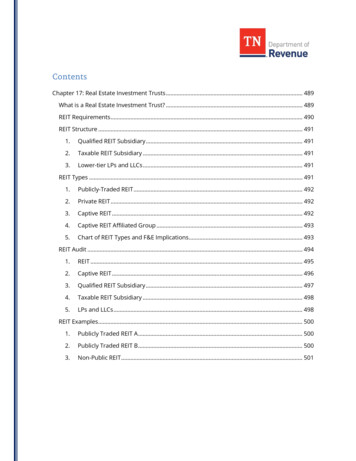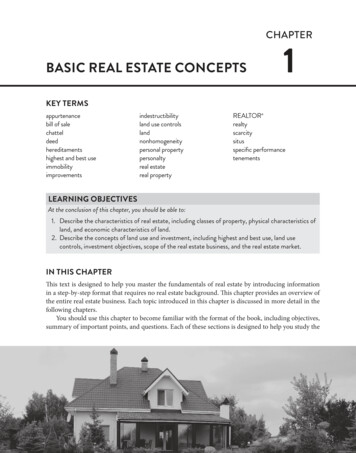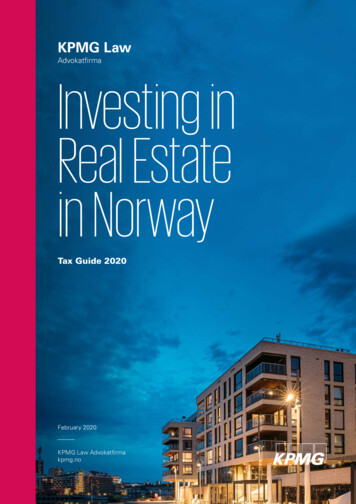
Transcription
Building the FRamewoRk to Reachthe Right Real estate decisionsKey Features incluDe:New topics in various chapters have been added to provide coverage on important topicssuch as market analysis for projecting occupancy and rental growth, installment sales, taxfree exchanges, valuing REITs, and the current economic landscape.New concept boxes in select chapters provide information about recent trends in mortgagebacked securities and how the government has worked to add liquidity to mortgage markets,in addition to taking over the Federal Home Loan Mortgage Corporation.Student-friendly pedagogical features are integrated throughout the text, such as calculatorhints with solutions. Traditional table solutions are also shown in the early chapters to aid inthe understanding of the time-value of money.JeFFrey D. Fisher14theditionCourSeSmartL e a r n m o r e a b o u t r e s o u r c e s ava i L a b L e t o y o u atwww.mhhe.com/bf14eISBN 978-0-07-337733-9MHID 0-07-337733-390000BrueggemanFisherCourseSmart is a new way to find and buy eTextbooks. At CourseSmart youcan save up to 50% of the cost of your print textbook, reduce your impacton the environment, and gain access to powerful web tools for learning.Try a free chapter to see if it’s right for you. Visit www.CourseSmart.com and search by title,author, or ISBN.Real estate Financeand investmentsEAN9780073 377339fourteenth editionwww.mhhe.com@GUSTpdfMD DALIM #1065290 01/10/10 CYAN MAG YELO BLKReal estate Financeand investmentsThe Fourteenth Edition of Real Estate Finance and Investments prepares students to understandthe risks and rewards associated with investing in and financing both residential and commercial real estate. Factors such as legal issues that can impact the rights of lenders and investors,characteristics of various vehicles for real estate lending and investing, the importance of thelocal economy, and the goals of the lender or investor are detailed so that students can performthe right kind of analysis to make informed real estate finance and investment decisions.William B. Brueggeman
bru77333 fm i-xviii.qxd1/13/1010:5445Page iReal EstateFinance andInvestmentsConfirming Pages
bru77333 fm i-xviii.qxd1/13/1010:5445Confirming PagesPage iiThe McGraw-Hill/Irwin Series in Finance, Insurance, and Real EstateStephen A. RossFranco Modigliani Professor of Finance andEconomicsSloan School of ManagementMassachusetts Institute of TechnologyConsulting EditorFINANCIAL MANAGEMENTAdairExcel Applications for Corporate FinanceSecond EditionBlock, Hirt, and DanielsenFoundations of Financial ManagementThirteenth EditionBrealey, Myers, and AllenPrinciples of Corporate FinanceTenth EditionBrealey, Myers, and AllenPrinciples of Corporate Finance, ConciseSecond EditionBrealey, Myers, and MarcusFundamentals of Corporate FinanceSixth EditionBrooksFinGame Online 5.0BrunerCase Studies in Finance: Managing forCorporate Value CreationSixth EditionChewThe New Corporate Finance: WhereTheory Meets PracticeThird EditionCornett, Adair, and NofsingerFinance: Applications and TheoryFirst EditionDeMelloCases in FinanceSecond EditionGrinblatt (editor)Stephen A. Ross, Mentor: Influencethrough GenerationsFirst EditionGrinblatt and TitmanFinancial Markets and CorporateStrategySecond EditionHigginsAnalysis for Financial ManagementNinth EditionKellisonTheory of InterestThird EditionKester, Ruback, and TufanoCase Problems in FinanceTwelfth EditionRoss, Westerfield, and JaffeCorporate FinanceNinth EditionRoss, Westerfield, Jaffe, and JordanCorporate Finance: Core Principles andApplicationsSecond EditionRoss, Westerfield, and JordanEssentials of Corporate FinanceSeventh EditionRoss, Westerfield, and JordanFundamentals of Corporate FinanceNinth EditionShefrinBehavioral Corporate Finance: DecisionsThat Create ValueFirst EditionWhiteFinancial Analysis with an ElectronicCalculatorSixth EditionINVESTMENTSBodie, Kane, and MarcusEssentials of InvestmentsEighth EditionBodie, Kane, and MarcusInvestmentsEighth EditionHirt and BlockFundamentals of Investment ManagementNinth EditionHirschey and NofsingerInvestments: Analysis and BehaviorSecond EditionJordan and MillerFundamentals of Investments: Valuationand ManagementFifth EditionStewart, Piros, and HeislerRunning Money: Professional PortfolioManagementFirst EditionSundaram and DasDerivatives: Principles and PracticeFirst EditionFINANCIAL INSTITUTIONSAND MARKETSRose and HudginsBank Management and Financial ServicesEighth EditionRose and MarquisMoney and Capital Markets: FinancialInstitutions and Instruments in a GlobalMarketplaceTenth EditionSaunders and CornettFinancial Institutions Management:A Risk Management ApproachSeventh EditionSaunders and CornettFinancial Markets and Institutions: AnIntroduction to the Risk ManagementApproachFourth EditionINTERNATIONAL FINANCEEun and ResnickInternational Financial ManagementFifth EditionKuemmerleCase Studies in InternationalEntrepreneurship: Managing andFinancing Ventures in the GlobalEconomyFirst EditionRobinInternational Corporate FinanceFirst EditionREAL ESTATEBrueggeman and FisherReal Estate Finance and InvestmentsFourteenth EditionLing and ArcherReal Estate Principles: A Value ApproachThird EditionFINANCIAL PLANNINGAND INSURANCEAllen, Melone, Rosenbloom, and MahoneyRetirement Plans: 401(k)s, IRAs, andOther Deferred CompensationApproachesTenth EditionAltfestPersonal Financial PlanningFirst EditionHarrington and NiehausRisk Management and InsuranceSecond EditionKapoor, Dlabay, and HughesFocus on Personal Finance: An ActiveApproach to Help You Develop SuccessfulFinancial SkillsThird EditionKapoor, Dlabay, and HughesPersonal FinanceNinth Edition
bru77333 fm i-xviii.qxd1/13/1010:5445Confirming PagesPage iiiReal EstateFinance andInvestmentsFourteenth EditionWilliam B. Brueggeman,Ph.D.Corrigan Chair in Real EstateEdwin L. Cox School of BusinessSouthern Methodist UniversityJeffrey D. Fisher, Ph.D.Charles H. and Barbara F. Dunn Professorof Real EstateKelley School of BusinessIndiana University
bru77333 fm i-xviii.qxd 1/20/10 10:5245 Page ivREAL ESTATE FINANCE AND INVESTMENTSPublished by McGraw-Hill/Irwin, a business unit of The McGraw-Hill Companies, Inc., 1221 Avenue of theAmericas, New York, NY, 10020. Copyright 2011, 2008, 2005, 2002, 1997, 1993, 1989, 1981, 1977 by TheMcGraw-Hill Companies, Inc. All rights reserved. No part of this publication may be reproduced or distributedin any form or by any means, or stored in a database or retrieval system, without the prior written consent of TheMcGraw-Hill Companies, Inc., including, but not limited to, in any network or other electronic storage ortransmission, or broadcast for distance learning.Some ancillaries, including electronic and print components, may not be available to customers outside theUnited States.This book is printed on acid-free paper.1 2 3 4 5 6 7 8 9 0 WDQ/WDQ 1 0 9 8 7 6 5 4 3 2 1 0ISBN 978-0-07-337733-9MHID 0-07-337733-3Vice president and editor-in-chief: Brent GordonPublisher: Douglas ReinerExecutive editor: Michele JanicekDirector of development: Ann TorbertSenior development editor: Christina KouvelisEditorial coordinator: Alyssa OtternessVice president and director of marketing: Robin J. ZwettlerAssociate marketing manager: Dean KarampelasVice president of editing, design and production: Sesha BolisettyProject manager: Dana M. PauleyLead production supervisor: Michael R. McCormickDesigner: Matt DiamondMedia project manager: Suresh Babu, Hurix Systems Pvt. Ltd.Typeface: 10/12 Times New RomanCompositor: Laserwords Private LimitedPrinter: WorldcolorLibrary of Congress Cataloging-in-Publication DataBrueggeman, William B.Real estate finance and investments / William B. Brueggeman, Jeffrey D. Fisher.—14th ed.p. cm.—(The McGraw-Hill/Irwin series in finance, insurance, and real estate)Includes index.ISBN-13: 978-0-07-337733-9 (alk. paper)ISBN-10: 0-07-337733-3 (alk. paper)1. Mortgage loans—United States. 2. Real property—United States—Finance. I. Fisher,Jeffrey D. II. Title.HG2040.5.U5B78 2011332.7'2—dc222009053484www.mhhe.comRev. Confirming Pages
bru77333 fm i-xviii.qxd 1/20/10 04:29 PM Page vRev. Confirming PagesPrefaceIntroduction to Real Estate Finance and InvestmentsThis book prepares readers to understand the risks and rewards associated with investing inand financing both residential and commercial real estate. Concepts and techniques included in the chapters and problem sets are used in many careers related to real estate.These include investing, development financing, appraising, consulting, managing real estate portfolios, leasing, managing property, analyzing site locations, and managing corporate real estate. This material is also relevant to individuals who want to better understandreal estate for their own personal investment and financing decisions.The recent turmoil in world financial markets, which has been closely tied to events inthe real estate market, suggests that investors, lenders, and others who participate in the realestate market need to better understand how to evaluate the risk and return associated withthe various ways of investing and lending. This requires an understanding of the legal issuesthat can impact the rights of lenders and investors, the characteristics of the various vehicles for lending and investing in real estate, the economic benefits of the loan or investment, the importance of the local economy where properties are located, and the goals ofthe particular lender or investor.This book is designed to help students and other readers learn how to understand thesefactors, so that they can perform the right kind of analysis and make informed real estatefinance and investment decisions. As the book’s title suggests, we discuss both real estatefinance and real estate investments. These topics are inter-related. For example, an investorwho purchases a property is making an “investment.” This investment is typically financedwith a mortgage loan. Thus, the investor needs to understand both how to analyze the investment and how financing the investment will impact its risk and return.Similarly, the lender, by providing capital for the investor to purchase the property, isalso making an “investment” in the sense that he or she expects to get some rate of returnon the money that has been loaned. Therefore, the lender also needs to understand the riskand return of making that loan. In fact, one of the risks associated with loaning money isthat the lender may end up owning the property. So the lender needs to evaluate the property in many of the same ways as the investor purchasing the property.Organization of the BookFrom the above discussion it should be clear that many factors have an impact on the riskand return associated with property investments and the mortgages used to finance them.This is true whether the investment is in your personal residence or in a large incomeproducing investment such as an office building.Part I of the book begins with a discussion of the legal concepts that are important inthe study of real estate finance and investments. Although a real estate investor or lendermay rely heavily on an attorney in a real estate transaction, it is important to know enoughto be able to ask the right questions. We focus on those legal issues that relate to real estateinvestment and financing decisions.Part II begins with a discussion of the time value of money concepts important for analyzing real estate investments and mortgages. These concepts are important because realestate is a long-term investment and is financed with loans that are repaid over time. Thisleads to a discussion of the primary ways that mortgage loans are structured: fixed rate andadjustable rate mortgage loans.v
bru77333 fm i-xviii.qxdvi1/13/1010:5445Page viConfirming PagesPrefacePart III focuses on residential housing as an investment as well as loan underwriting forresidential properties. This is relevant for individuals making personal financial decisions,such as whether to own or rent a home, as well as for lenders who are evaluating a loan anda borrower.Part IV covers many topics related to analyzing income property investments such asapartments, office buildings, shopping centers, and so on. These topics include understanding leases, knowing how properties are appraised, and being able to analyze the potential returns and risks of an investment and how taxes impact the return. We also considerhow to evaluate whether a property should be sold or renovated. Finally, we look at howcorporations that are not in the real estate business per se, but that use real estate as part oftheir business, can decide whether to own or lease the property they use.While the first four parts focus on investing or financing existing properties, Part V discusses how to analyze proposed projects, such as the development of an apartment or office building or the development of land for sale to builders. It also discusses how projectsare financed during the development period, which is different from the way properties arefinanced once construction is complete and they are occupied.Part VI discusses various alternative real estate financing and investment vehicles. Westart with joint ventures, which allow different parties with different areas of expertise anddifferent amounts of capital to join forces for the purpose of making a real estate investment. For example, someone with development expertise who needs equity capital may enter into a joint venture with an investor who has capital to invest but doesn’t have theexpertise to do the development. Next, we discuss the secondary market for both residential and commercial mortgages and examine how mortgage-backed securities are structured. This includes a discussion of the risks these investments pose, which is important tomaking sound investments. Part VI also includes a discussion of real estate investmenttrusts (REITs). These public companies invest in real estate and allow investors to own adiversified portfolio of real estate by purchasing shares of stock in the company. Finally, wediscuss how to evaluate real estate in a portfolio that also includes other investments suchas stocks and bonds. This includes understanding the diversification benefits of includingreal estate in a portfolio as well as ways to diversify within the real estate portfolio (including international investment).Wide AudienceFrom the above discussion, one can see that this book covers many topics. Depending onthe purpose of the particular course, not all of the topics will be covered. The focus of thecourse may lean toward an investor’s perspective (real estate investment) or a lender’s perspective (real estate finance). Some courses will emphasize housing and residential real estate more than others, and some will have a different emphasis on development. This bookis designed to allow flexibility for instructors and students to focus on those topics that aremost important to them, so that it can meet the purpose of each unique course.Changes to the Fourteenth EditionSeveral new topics have been added to the fourteenth edition. Some of these were in responseto the recent turmoil in the financial markets, caused in part by the problems associated withsubprime mortgages. While the previous edition of the book discussed subprime mortgages,this edition adds further emphasis to the importance of proper underwriting of mortgageloans, whether they are subprime or not and whether they are for residential or commercialproperties. Many new concept boxes have been added to provide information about recenttrends in mortgage-backed securities and how the government has worked to add liquidity tomortgage markets, in addition to taking over the Federal Home Loan Mortgage Corporation.
bru77333 fm i-xviii.qxd 1/20/10 10:5245 Page viiRev. Confirming PagesPreface viiThe chapters that discuss the different ways mortgages can be structured have alsobeen expanded, so that readers can understand all the ways in which a mortgage can bestructured and the associated risks with each structuring.A new section on market analysis has been added to provide readers with a better understanding of how data on the supply and demand for real estate can be used to project occupancy and rental growth. For more advanced readers, a new concept box describesstatistical techniques that can be used in market analysis.Also new to this edition, a discussion has been added that outlines the various ownership structures that can be used for ownership of investment property, along with the advantages and disadvantages of each.Because investors often look for ways to defer capital gains taxes when selling investment properties, a new section has been added on installment sales and tax-free exchanges. This includes a discussion on how to evaluate whether these tax-deferralstrategies are better than a regular sale.The chapter on real estate investment trusts (REITs) has been expanded to reflect thecurrent economic landscape and also to include discussion on how to value a REIT. SinceREITs are companies that invest in real estate, the value of the properties they hold is important, but techniques commonly used to value corporations such as earnings multipliersand dividend discount models are also important.Finally, we have expanded the integration of financial calculators and Excel into thesolutions of problems, since this is what is done in practice. The way that solutions are presented has been simplified by using new notation introduced in this edition.Excel Spreadsheets and ARGUS SoftwareThe book is rigorous yet practical and blends theory with applications to real-world problems.These problems are illustrated and solved by using a blend of financial calculators, Excelspreadsheets, and specialized software designed to analyze real estate income property. Excelspreadsheets, provided on the book’s Web site at www.mhhe.com/bf14e, are an aid for students to understand many of the exhibits displayed in chapters throughout the text. By modifying these exhibits, students also may solve many end-of-chapter problems without havingto design new spreadsheets.ARGUS Valuation DCF is used in several chapters to supplement the use of Excelspreadsheets to solve investment analysis and valuation problems. ARGUS data files, available on the book’s Web site at www.mhhe.com/bf14e, replicate the examples in the book.An educational version of the ARGUS Valuation DCF software can be obtained for studentsusing this book in their course. First the professor must send a list of students to ARGUSSoftware, and then individual students can request a license that allows them to use ARGUSValuation DCF while they are enrolled in the course. Professors and students can contactARGUS Software by sending an email to StudentLicense@argussoftware.com.Internet Tools and AssetsMaking informed real estate investment and financing decisions depends on being able toobtain useful information. Such information may include national and local market trends,interest rates, properties available for acquisition, financing alternatives, and the opinionsof experts concerning the outlook for various real estate sectors.The Internet now provides a rich source of information to real estate investors and lenders.Knowing how to find information on the Web is an important part of the “due diligence” thatshould be done before making any real estate investments. This edition includes a numberof Web App boxes that provide exercises that require finding relevant information on the
bru77333 fm i-xviii.qxd 1/20/10 10:5245 Page viiiRev. Confirming Pagesviii PrefaceInternet. These Web App boxes provide practical examples of the types of data and other resources that are available on the Internet. The fourteenth edition also contains Web site references that students can use to research various real estate topics. In addition to research,these resources provide readers with an opportunity to remain current on many of the topics discussed in the book.The book’s Web site, located at www.mhhe.com/bf14e, contains additional helpfulmaterials for students such as Web links, multiple-choice quizzes, Excel spreadsheets,ARGUS data files, and appendixes to the text. Using a password-protected instructorlog-in, instructors can find a solutions manual, test bank, and PowerPoint presentations.SupplementsSeveral ancillary materials are available for instructor use. These include: Solutions Manual—developed by Jeffrey Fisher and William Brueggeman. Test Bank—developed by Eric Fruits, Portland State University. PowerPoint slides—developed by Joshua Kahr, Columbia University.AcknowledgmentsWe would like to thank several people who contributed to recent editions by either being areviewer or providing feedback to us in other ways that helped improve the current edition:Edward BarylaEast Tennessee State UniversityRobert Berlinger, Jr.University Institute of TechnologyRoy T. BlackGeorgia State UniversityThomas P. BoehmUniversity of Tennessee-KnoxvilleThomas BothemUniversity of Illinois at ChicagoWally BoudryUniversity of North Carolina-Chapel HillGrace Wong BucchianeriWharton School, University of PennsylvaniaPing ChengFlorida Atlantic UniversityJohn FaySanta Clara UniversityMichael FratantoniGeorgetown UniversityEric FruitsPortland State UniversityDeborah W. GregoryUniversity of ArizonaArie HalachmiTennessee State University (USA)Sun Yat-Sen University (China)Barry HershNYU-SCPS Real Estate InstituteSamuel KahnTouro CollegeJoshua KahrColumbia UniversityW. Keith MunsellBoston UniversityMichael SchonbergerRutgers University-New BrunswickTracey SeslenUniversity of Southern CaliforniaCarlos SlawsonLouisiana State UniversityJan StrockisSanta Clara University
bru77333 fm i-xviii.qxd1/13/1010:5445Page ixConfirming PagesPreface ixIn addition, we are grateful to Robert Martin, MAI, who helped prepare the ARGUSexamples used in the book. Ron Donohue with the Homer Hoyt Institute helped revise thechapter on real estate investment trusts. Youguo Liang at Prudential Real Estate Investorsprovided significant input on the structure of joint ventures. Charles Johnson and AaronTemple helped with Web references. Jacey Leonard helped prepare the Excel templatesfor the previous edition that were used in this edition. Anand Kumar helped with Webreferences and spreadsheets. Candi Duke helped in the preparation and submission of themanuscript. Ji’ Reh Kore helped with research on recent trends impacting the real estatefinance industry, as well as with the preparation of the Solutions Manual. Deverick Jordanand Diem Chau also helped with the Solutions Manual and with chapter exhibits. NathanHastings helped update the legal chapters and provided input on the ownership structuresused for real estate.We will miss the late Theron Nelson, who contributed to prior editions of the book,including creating the original version of several of the spreadsheet templates. We appreciate his contributions to this book and to the real estate profession.Our thanks to the book team at McGraw-Hill/Irwin for their help in developing the newedition: Michele Janicek, executive editor; Christina Kouvelis, senior developmentaleditor; Alyssa Otterness, editorial coordinator; Dean Karampelas, marketing manager;Suresh Babu, media project manager; Dana Pauley, project manager; Michael McCormick,lead production supervisor; and Matt Diamond, designer.We also continue to be indebted to people who have contributed to previous editions,especially the late Henry E. Hoagland, who wrote the first edition of this book, and Leo D.Stone, who participated in several editions. Finally, we thank all of the adopters of previouseditions of the book, who, because of their feedback, have made us feel that we have helpedthem prepare students for a career in real estate.William B. BrueggemanJeffrey D. Fisher
bru77333 fm i-xviii.qxd 1/20/10 10:5245 Page xRev. Confirming PagesBrief ContentsPART ONEOverview of Real Estate Finance andInvestments1 Real Estate Investment: Basic LegalConcepts 12 Real Estate Financing: Notes andMortgages 16PART TWOMortgage Loans3 Mortgage Loan Foundations: The TimeValue of Money 424 Fixed Interest Rate Mortgage Loans 775 Adjustable and Floating Rate MortgageLoans 1206 Mortgages: Additional Concepts, Analysis,and Applications 148PART THREEResidential Housing7 Single Family Housing: Pricing,Investment, and Tax Considerations 1838 Underwriting and Financing ResidentialProperties 222PART FOURIncome-Producing Properties9 Income-Producing Properties: Leases,Rents, and the Market for Space 25410 Valuation of Income Properties: Appraisaland the Market for Capital 296x11 Investment Analysis and Taxation ofIncome Properties 33912 Financial Leverage and FinancingAlternatives 38113 Risk Analysis 41814 Disposition and Renovation of IncomeProperties 44915 Financing Corporate Real Estate 485PART FIVEFinancing Real Estate Development16 Financing Project Development 50817 Financing Land DevelopmentProjects 545PART SIXAlternative Real Estate Financing andInvestment Vehicles18 Structuring Real Estate Investments:Organizational Forms and JointVentures 57419 The Secondary Mortgage Market:Pass-Through Securities 60820 The Secondary Mortgage Market: CMOsand Derivative Securities 63521 Real Estate Investment Trusts (REITs) 67822 Real Estate Investment Performance andPortfolio Considerations 710INDEX 739
bru77333 fm i-xviii.qxd1/13/1010:5445Confirming PagesPage xiTable of ContentsPART ONEOVERVIEW OF REAL ESTATE FINANCEAND INVESTMENTSChapter 1Real Estate Investment: Basic Legal Concepts 1Property Rights and Estates2Definition of Estate 4Two General Classifications of Estates 4Examples of Freehold Estates 4Estates Not Yet in Possession (Future Estates)Examples of Leasehold Estates 5Interests, Encumbrances, and EasementsAssurance of Title 7The Meaning of TitleDeeds 969Recording Acts 12Limitations on Property Rights1337Compound Interest 42Compound or Future ValueChapter 2Real Estate Financing: Notes andMortgages 16Using Financial Functions: Calculators andSpreadsheets 49Present Value 52A Graphic Illustration of Present Value 52Expanding the Use of Calculators for Finding PresentValues 54Definition of a Mortgage 18Relationship of Note to Mortgage 18Interests That Can Be Mortgaged 19Minimum Mortgage Requirements 19Important Mortgage Clauses 20Assumption of Mortgage 22Acquiring Title “Subject to” a MortgageCompound or Future Value of an Annuity56Use of Compound Interest Factors for AnnuitiesPresent Value of an Annuity5860Use of the Present Value of an Annuity Factors 6123Property Covered by a Mortgage 23Junior Mortgages 24Recording of Mortgages 2424242526Alternatives to Foreclosure: Workouts 26Restructuring the Mortgage Loan 27Transfer of Mortgage to a New Owner 28Voluntary Conveyance 2943Calculating Compound Interest Factors 47Notes 16The Mortgage Instrument 18What Constitutes Default?37Chapter 7 LiquidationChapter 11 38Chapter 13 39Chapter 3Mortgage Loan Foundations: The Time Valueof Money 42Abstract and Opinion Method 11The Title Insurance Method 11Land ContractsDefault 26Bankruptcy531Judicial Foreclosure 31Redemption 32Sales of Property 32Effect of Foreclosure on Junior Lienors 35Deficiency Judgment 35Taxes in Default 36MORTGAGE LOANSMethods of Title AssuranceSeller FinancingForeclosurePART TWO7Other Financing SourcesFriendly Foreclosure 30Prepackaged Bankruptcy 30Short Sale 30Accumulation of a Future Sum 64Determining Yields, or Internal Rates of Return, onInvestments 65Investments with Single Receipts 65Yields on Investment Annuities 68Equivalent Nominal Annual Rate (ENAR): Extensions 70Solving for Annual Yields with Partial Periods: AnExtension 72Chapter 4Fixed Interest Rate Mortgage Loans77Determinants of Mortgage Interest Rates: A BriefOverview 77xi
bru77333 fm i-xviii.qxd 1/20/10 10:5245 Page xiixiiRev. Confirming PagesTable of ContentsThe Real Rate of Interest: UnderlyingConsiderations 78Interest Rates and Inflation Expectations 78Interest Rates and Risk 79A Summary of Factors Important in MortgageLoan Pricing 81Understanding Fixed Interest Rate Mortgage (FRM)Loan Terms 81Calculating Payments and Loan Balances—FixedInterest Rate Loans 83The Importance of Accrued Interest and LoanPayments 83Loan Amortization Patterns 83Fully Amortizing, Constant Payment Mortgage (CPM)Loans 84Partially Amortizing, Constant Payment Mortgage (CPM)Loans 88Zero Amortizing, or Interest Only Constant PaymentMortgage (CPM) Loans 89Negative Amortizing, Constant Payment Mortgage (CPM)Loans 90Summary and Comparisons: Fixed Interest Rate,Constant Payment Mortgage (CPM) Loans withVarious Amortization Patterns 91Determining Loan Balances 92Finding Loan Balances—Other AmortizationPatterns 94Loan Closing Costs and Effective Borrowing Costs 95Loan Fees and Early Repayment: Fully AmortizingLoans 98Charging Fees to Achieve Yield, or “Pricing” FRMs 102Other FRM Loan Patterns––Declining Payments andConstant Amortization Rates 103Amortization Schedules and Callable Loans 104Reverse Annuity Mortgages (RAMs) 105AppendixInflation, Mortgage Pricing, and PaymentStructuring 111Chapter 5Adjustable and Floating Rate MortgageLoans 120The Price Level AdjustedMortgage (PLAM) 122PLAM: Payment Mechanics 122ARMs and Floating Rate Loans: An Overview 124Variations: ARM and Floating Rate Loans 127Risk Premiums, Interest Rate Risk, and DefaultRisk 131Expected Yield Relationships and Interest Rate Risk 133More Complex Features 134ARM Payment Mechanics 136Expected Yields on ARMs: A Comparison 141Chapter 6Mortgages: Additional Concepts, Analysis,and Applications 148Incremental Borrowing Cost 148Early Repayment 150Origination Fees 151Incremental Borrowing Cost versus a SecondMortgage 152Relationship between the Incremental Cost and theLoan-to-Value Ratio 152Differences in Maturities 155Loan Refinancing 156Early Repayment: Loan Refinancing 157Effective Cost of Refinancing 159Borrowing the Refinancing Costs 159Other Considerations 160Early Loa
Introduction to Real Estate Finance and Investments This book prepares readers to understand the risks and rewards associated with investing in and financing both residential and commercial real estate. Concepts and techniques in-cluded in the chapters and problem sets are used










